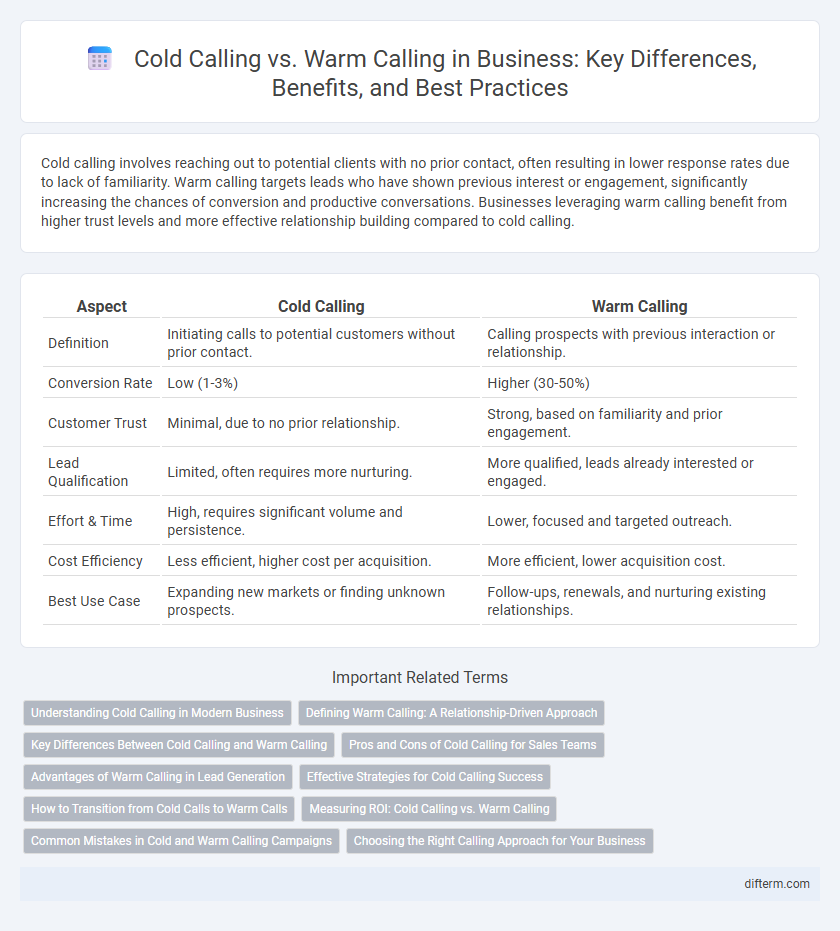Cold calling involves reaching out to potential clients with no prior contact, often resulting in lower response rates due to lack of familiarity. Warm calling targets leads who have shown previous interest or engagement, significantly increasing the chances of conversion and productive conversations. Businesses leveraging warm calling benefit from higher trust levels and more effective relationship building compared to cold calling.
Table of Comparison
| Aspect | Cold Calling | Warm Calling |
|---|---|---|
| Definition | Initiating calls to potential customers without prior contact. | Calling prospects with previous interaction or relationship. |
| Conversion Rate | Low (1-3%) | Higher (30-50%) |
| Customer Trust | Minimal, due to no prior relationship. | Strong, based on familiarity and prior engagement. |
| Lead Qualification | Limited, often requires more nurturing. | More qualified, leads already interested or engaged. |
| Effort & Time | High, requires significant volume and persistence. | Lower, focused and targeted outreach. |
| Cost Efficiency | Less efficient, higher cost per acquisition. | More efficient, lower acquisition cost. |
| Best Use Case | Expanding new markets or finding unknown prospects. | Follow-ups, renewals, and nurturing existing relationships. |
Understanding Cold Calling in Modern Business
Cold calling remains a critical strategy in modern business for generating new leads and expanding market reach. Unlike warm calling, which targets prospects with prior engagement, cold calling involves contacting potential clients with no previous interaction, requiring tailored scripts and persistence to build rapport. Effective cold calling integrates data-driven insights and personalized messaging to overcome barriers and convert prospects into customers.
Defining Warm Calling: A Relationship-Driven Approach
Warm calling centers on engaging prospects with pre-established context or previous interactions to foster trust and rapport. This relationship-driven approach leverages existing connections, referrals, or leads who have shown interest, significantly improving response rates compared to cold calling. By utilizing personalized communication and addressing specific needs, warm calling enhances relationship-building and accelerates the sales cycle.
Key Differences Between Cold Calling and Warm Calling
Cold calling involves reaching out to potential customers who have had no prior interaction with your business, making it a more challenging method with typically lower conversion rates and higher rejection. Warm calling targets leads who have shown interest or engaged with your brand through previous interactions, resulting in higher trust and a significantly better chance of successful engagement. The key differences lie in the prospect's familiarity with the company, the quality of the lead, and the overall approach to relationship-building in the sales process.
Pros and Cons of Cold Calling for Sales Teams
Cold calling allows sales teams to reach a broad audience quickly, potentially uncovering new leads in untapped markets, but often results in low conversion rates due to unfamiliarity and resistance from prospects. It requires significant time investment and resilience from sales representatives to handle frequent rejections and maintain motivation. Despite these challenges, cold calling remains a cost-effective method to generate initial contact and can be optimized through targeted lists and scripting to improve success rates.
Advantages of Warm Calling in Lead Generation
Warm calling enhances lead generation by engaging prospects who have already shown interest or interacted with the brand, increasing conversion rates compared to cold calling. It fosters trust and rapport early in the conversation, leading to more meaningful and productive discussions. This approach reduces rejection rates and improves overall sales efficiency by targeting warmer, pre-qualified leads.
Effective Strategies for Cold Calling Success
Cold calling success hinges on precise targeting, clear value propositions, and active listening to address prospects' pain points effectively. Incorporating personalization, researching leads beforehand, and maintaining a confident yet empathetic tone increase engagement rates. Utilizing CRM tools to track interactions and follow-ups ensures consistent communication and higher conversion potential.
How to Transition from Cold Calls to Warm Calls
Transitioning from cold calls to warm calls involves leveraging initial outreach data to build personalized communication and establish rapport, increasing engagement rates significantly. Utilizing CRM tools to track responses and segment leads based on interaction history allows sales teams to tailor follow-up conversations, shifting from generic pitches to relevant value propositions. Implementing strategic nurturing through email campaigns, social media touchpoints, and content sharing transforms cold prospects into warm leads ready for meaningful dialogue.
Measuring ROI: Cold Calling vs. Warm Calling
Measuring ROI for cold calling often reveals lower conversion rates due to the impersonal nature of unsolicited outreach, leading to higher costs per acquisition. Warm calling typically generates higher ROI as it leverages existing relationships or prior engagement, resulting in increased trust and faster decision-making. Businesses analyzing metrics such as lead conversion rate, cost per lead, and average deal size find warm calling more efficient for long-term growth and profitability.
Common Mistakes in Cold and Warm Calling Campaigns
Common mistakes in cold calling campaigns include lack of targeted research, leading to irrelevant pitches and high rejection rates, and failure to build rapport quickly, which disengages prospects. In warm calling, errors often involve insufficient follow-up on previous interactions and neglecting to personalize messages based on the prospect's history, reducing trust and conversion potential. Both approaches suffer when sales teams rely on generic scripts instead of adapting their communication to the specific needs and behaviors of the audience.
Choosing the Right Calling Approach for Your Business
Choosing the right calling approach significantly impacts business conversion rates, with cold calling often yielding lower response rates compared to warm calling, which leverages prior contact or interest. Warm calling enhances customer engagement by building trust and increasing the likelihood of successful sales through personalized interactions. Businesses should analyze their target audience, sales objectives, and available data to determine whether a warm calling strategy aligns better with higher ROI and customer retention goals.
cold calling vs warm calling Infographic

 difterm.com
difterm.com